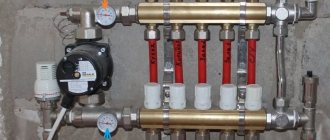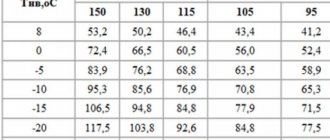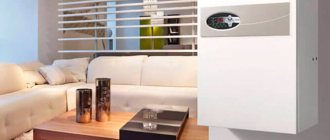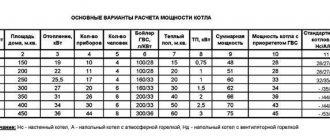How many square meters require heating? Buyers often make the mistake of automatically calculating heating only for the usable area. In fact, in fact, the heated area of the building is usually larger. For example, staircase openings are not included in the usable area.
For heating, the total area of the building is calculated, that is, the sum of the floor areas of the heated premises. The calculation is carried out using the house plan; the area of the building contour is taken into account (after subtracting the thickness of the external walls) * the number of heated floors.
Example: a one-story house 10*10 m with an attic, walls 50 cm thick. The usable area will not exceed 140 m², and the heated area will be:
9 x 9 x 2 = 162 m².
We remove from the calculation unheated rooms located in the building. The area of premises that are heated to a temperature lower than the rest of the building (for example, a garage or boiler room) is divided in half.
How many battery sections are there for a room of 18 sq. m?
Number of sections
There will be fewer bimetallic radiators, they have higher efficiency, aluminum ones - lower.
Accordingly, for a standard room of 18-20
square meters you need 2 cast iron radiators of 8
sections
or 1 bimetallic block of 12 parts.
Interesting materials:
What does the word Ciao Bambino mean? What does the word Ciao mean in Italian? What does the word charter mean? What does the word Cheburashka mean? What does the word chsv mean? What does the word dude mean according to Dahl? What does the word Copyright mean? What does the word decadence mean? What does the word declaration mean in Latin? What does the word development mean?
DETERMINATION OF HEATED AREA AND VOLUME OF BUILDINGS
5.4.1The heated area of a building should be defined as the area of the floors (including the attic, heated basement and basement) of the building, measured within the internal surfaces of the external walls, including the area occupied by partitions and internal walls. In this case, the area of staircases and elevator shafts is included in the floor area.
The heated area of the building does not include the area of warm attics and basements, unheated technical floors, basement (underground), cold unheated verandas, unheated staircases, as well as a cold attic or part of it not occupied as an attic.
5.4.2 When determining the area of the attic floor, the area with a height up to a sloping ceiling of 1.2 m with an inclination of 30° to the horizon is taken into account; 0.8 m - at 45° - 60°; at 60° or more - the area is measured up to the baseboard.
5.4.3 The area of living quarters of a building is calculated as the sum of the areas of all common rooms (living rooms) and bedrooms.
5.4.4 The heated volume of a building is defined as the product of the heated floor area and the internal height, measured from the floor surface of the first floor to the ceiling surface of the last floor.
With complex shapes of the internal volume of a building, the heated volume is defined as the volume of space limited by the internal surfaces of external enclosures (walls, roofing or attic floor, basement).
To determine the volume of air filling the building, the heated volume is multiplied by a factor of 0.85.
5.4.5 The area of external enclosing structures is determined by the internal dimensions of the building. The total area of the external walls (including window and door openings) is determined as the product of the perimeter of the external walls along the internal surface and the internal height of the building, measured from the floor surface of the first floor to the ceiling surface of the last floor, taking into account the area of window and door slopes with a depth from the internal surface of the wall to the inner surface of a window or door block. The total area of windows is determined by the size of the openings in the light. The area of the external walls (opaque part) is determined as the difference between the total area of the external walls and the area of windows and external doors.
5.4.6 The area of horizontal external fences (covering, attic and basement floors) is determined as the floor area of the building (within the internal surfaces of the external walls).
With inclined surfaces of the ceilings of the last floor, the area of the roof, attic floor is determined as the area of the inner surface of the ceiling.
PRINCIPLES FOR DETERMINING THE REGULAR LEVEL OF THERMAL PROTECTION
6.1 The main objective of SNiP 23-02 is to ensure the design of thermal protection of buildings at a given thermal energy consumption to maintain the established parameters of the microclimate of their premises. At the same time, the building must also provide sanitary and hygienic conditions.
6.2 SNiP 23-02 establishes three mandatory mutually linked standardized indicators for the thermal protection of a building, based on:
“a” - standardized values of heat transfer resistance for individual building envelopes for thermal protection of the building;
“b” - standardized values of the temperature difference between the temperatures of the internal air and on the surface of the enclosing structure and the temperature on the internal surface of the enclosing structure above the dew point temperature;
“c” - a standardized specific indicator of thermal energy consumption for heating, which allows you to vary the values of the heat-protective properties of enclosing structures, taking into account the choice of systems for maintaining standardized microclimate parameters.
The requirements of SNiP 23-02 will be met if, when designing residential and public buildings, the requirements of indicators of groups “a” and “b” or “b” and “c” are met, and for industrial buildings - indicators of groups “a” and “b” " The choice of indicators by which the design will be carried out falls within the competence of the design organization or the customer. Methods and ways to achieve these standardized indicators are selected during design.
All types of enclosing structures must meet the requirements of indicators “b”: provide comfortable living conditions for people and prevent indoor surfaces from getting wet, wet and mold.
6.3 According to indicators “c”, the design of buildings is carried out by determining the complex value of energy saving from the use of architectural, construction, thermal and engineering solutions aimed at saving energy resources, and therefore, if necessary, in each specific case, it is possible to establish less normalized values than according to indicators “a”. heat transfer resistance for certain types of enclosing structures, for example, for walls (but not lower than the minimum values established in 5.13 SNiP 23-02).
6.4 In the process of designing a building, the calculated indicator of specific heat energy consumption is determined, which depends on the heat-protective properties of the enclosing structures, space-planning solutions of the building, heat release and the amount of solar energy entering the premises of the building, the efficiency of engineering systems for maintaining the required microclimate of the premises and heat supply systems. This calculated indicator should not exceed the standardized indicator.
6.5 Designing according to “B” indicators provides the following advantages:
— there is no need for individual elements of enclosing structures to achieve the standardized heat transfer resistance values specified in Table 4 of SNiP 23-02;
— an energy-saving effect is ensured through the integrated design of the building’s thermal protection and taking into account the efficiency of heat supply systems;
— greater freedom to choose design solutions during design.
Figure 1 — Scheme for designing thermal protection of buildings
6.6 The design diagram for thermal protection of buildings in accordance with SNiP 23-02 is presented in Figure 1. The selection of thermal protection properties of enclosing structures should be carried out in the following sequence:
— select external climatic parameters in accordance with SNiP 23-01 and calculate the degree-day of the heating period;
— select the minimum values of the optimal microclimate parameters inside the building according to the purpose of the building in accordance with GOST 30494, SanPiN 2.1.2.1002 and GOST 12.1.005. Establish operating conditions for enclosing structures A or B;
— develop a space-planning solution for the building, calculate the compactness index of buildings and compare it with the standardized value. If the calculated value is greater than the normalized value, then it is recommended to change the space-planning solution in order to achieve the normalized value;
— choose the requirements of indicators “a” or “b”.
According to indicators "a"
6.7 The choice of heat-protective properties of enclosing structures according to the standardized values of its elements is carried out in the following sequence:
— determine the standardized values of heat transfer resistance Rreq
enclosing structures (external walls, coverings, attic and basement floors, windows and lanterns, external doors and gates) by degree-day of the heating period;
check for the permissible value of the calculated temperature difference D tп
;
— they calculate the energy parameters for the energy passport, but do not control the specific heat energy consumption.
According to indicators "in"
6.8The selection of heat-protective properties of enclosing structures based on the standardized specific consumption of thermal energy for heating the building is carried out in the following sequence:
— determine, as a first approximation, element-by-element standards for heat transfer resistance Rreq
enclosing structures (external walls, coverings, attic and basement floors, windows and lanterns, external doors and gates) depending on the degree-day of the heating period;
— prescribe the required air exchange in accordance with SNiP 31-01, SNiP 31-02 and SNiP 2.08.02 and determine household heat emissions;
— assign a building class (A, B or C) for energy efficiency and, if class A or B is selected, set the percentage of reduction in standardized unit costs within the limits of standardized deviation values;
— determine the standardized value of the specific heat energy consumption for heating a building depending on the class of the building, its type and number of storeys and adjust this value in the case of assigning class A or B and connecting the building to a decentralized heat supply system or stationary electric heating;
— calculate the specific consumption of thermal energy for heating the building during the heating period, fill out the energy passport and compare it with the standardized value. The calculation is completed if the calculated value does not exceed the standardized value.
If the calculated value is less than the normalized value, then the following options are searched so that the calculated value does not exceed the normalized value:
- a decrease in comparison with the standardized values of the level of thermal protection for individual building fences, primarily for walls;
— changing the space-planning solution of the building (size, shape and layout of sections);
— selection of more efficient heat supply, heating and ventilation systems and methods of regulating them;
- a combination of previous options.
As a result of enumerating the options, new values of standardized heat transfer resistance Rreq
enclosing structures (external walls, coverings, attic and basement floors, windows, stained-glass windows and lanterns, external doors and gates), which may differ from those chosen as a first approximation, both smaller and larger. This value should not be lower than the minimum values specified in 5.13 SNiP 23-02.
Check for the permissible value of the calculated temperature difference D tп
.
6.9 Calculate thermal energy parameters in accordance with Section 7 and fill out an energy passport in accordance with Section 18 of this Code of Rules.
Calculator for accurately calculating the number of heating radiator sections
A simple calculation does not take into account many factors. The result is distorted data. Then some rooms remain cold, others too hot. The temperature can be controlled using shut-off valves, but it is better to accurately calculate everything in advance in order to use the right amount of materials.
For accurate calculations, decreasing and increasing thermal coefficients are used. First you should pay attention to the windows. For single glazing, a coefficient of 1.7 is used. Double windows do not require a factor. For triples the figure is 0.85.
If the windows are single and there is no thermal insulation, then the heat loss will be quite large.
When calculating, take into account the ratio of the area of floors and windows. The ideal ratio is 30%. Then a coefficient of 1 is applied. When the ratio increases by 10%, the coefficient increases by 0.1.
Coefficients for different ceiling heights:
- If the ceiling is below 2.7 m, the coefficient is not needed;
- For indicators from 2.7 to 3.5 m, a coefficient of 1.1 is used;
- When the height is 3.5-4.5 m, a coefficient of 1.2 will be required.
In the presence of attics or upper floors, certain coefficients are also applied. For a warm attic, an indicator of 0.9 is used, for a living room - 0.8. For unheated attics take 1.
Calculator for calculating heating radiators by area
The area register calculator is the easiest way to determine the required number of radiators per 1m2. Calculations are made based on power production standards. There are 2 main requirements of the norms, taking into account the climatic characteristics of the region.
- For temperate climates, the required power is 60-100 W;
- For northern regions the norm is 150-200 W.
Many people are interested in why the standards have such a wide range. But the power is selected based on the initial parameters of the house. Concrete buildings require maximum power ratings. Brick - medium, insulated - low.
All standards are taken into account with an average maximum shelf height of 2.7 m.
To calculate the sections, you will need to multiply the area by the norm and divide by the heat transfer of one section. Depending on the radiator model, the power of one section is taken into account. This information can be found in the technical data. Everything is quite simple and does not present any particular difficulties.
Non-residential basement with transit pipelines
As a rule, non-residential premises in apartment buildings have heating devices; accordingly, for their owners, heating fees are calculated in accordance with the general procedure. A special category consists of basement non-residential premises in which there are no heating radiators, but there are heating system pipelines.
Courts often refer to the currently inoperative Methodology for determining the amount of thermal energy and coolant in municipal heating water systems, approved by Order of the State Construction Committee of the Russian Federation dated May 6, 2000 No. 105. According to the note to clause 1 of Appendix 1 “Heating” to this document, a heated basement should consider a basement room in which, in order to maintain the design value of the air temperature, heating is provided by the design and carried out using heating devices (radiators, convectors, registers made of smooth or finned pipes) and (or) uninsulated pipelines of the heating system or heating network. In turn, if the project did not provide for basement heating, the above-mentioned pipelines must be covered with thermal insulation.
Accordingly, if, based on the results of an inspection of the premises, it is established that there are uninsulated pipelines of the heating system (usually supply and return) or hot water supply, and the temperature in the room corresponds to standard indicators in the absence of additional heating devices (for example, electric heaters), then the heating service is in this premises is provided and the owner is obliged to pay for it. Otherwise, it would mean imposing the obligation to pay for thermal energy spent on heating the defendant’s premises and not related to standard losses due to the lack of thermal insulation of pipes, on other owners of the premises of an apartment building (resolution of the Supreme Court of the Russian Federation dated 08/07/2015 in case No. A79-6883/2014 , Seventeenth Arbitration Court of Appeal dated November 18, 2015 in case No. A60-16073/2015).
At the same time, if an insulated pipeline is laid in the room and the air temperature is maintained by an electric heater, there is no reason to charge the owner for heating. Otherwise, it would mean that the contractor intends to recover from the owner of the premises the consumption of thermal energy for technological losses during its transportation, which are taken into account when approving the tariff (in relation to losses through external networks) and the consumption standard (in relation to intra-house losses), and if there is a utility cost, they are paid by the owners heated premises (resolutions of AS UO dated 02/11/2015 No. F09-10034/14, F09-9985/14, AS VSO dated 10/15/2014 in case No. A10-2458/2013, AS ZSO dated 02/20/2015 No. F04-15650/2015 , AS SZO dated October 27, 2015 in case No. A42-9616/2014).
Accurate calculation of the heater's thermal power:
To calculate thermal power, taking into account additional room conditions and temperature conditions, the following formula is used:
V × ΔT × K = kcal/hour
, or
V × ΔT × K / 860 = kW
, Where
V
— Volume of the heated room in cubic meters;
ΔT
— The difference between the air temperatures inside and outside. For example, if the outside air temperature is -5 °C and the required indoor temperature is +18 °C, then the temperature difference is 23 degrees;
K
— Thermal insulation coefficient of the room. It depends on the type of construction and insulation of the room.
K=3.0-4.0
— Simplified wooden or corrugated sheet metal construction.
No thermal insulation.
K=2.0-2.9
— Simplified building design, single brickwork, simplified window and roof design.
Little thermal insulation.
K=1.0-1.9
— Standard construction, double brickwork, few windows, standard roof.
Average thermal insulation.
K=0.6-0.9
— Improved building structure, double-insulated brick walls, few double-glazed windows, thick floor base, roof made of high-quality thermal insulation material.
High thermal insulation.
When choosing the value of the thermal insulation coefficient, you must take into account whether the building is old or new, since old buildings require more heat to warm up (accordingly, the value of the coefficient should be higher).
For our example, if we take into account the temperature difference (for example, 23 °C) and clarify the thermal insulation coefficient (for example, we have an old building with double brickwork, let’s take the value 1.9), then the calculation of the required thermal power of the heater will look like this:
150 × 23 × 1.9 / 860 = 7.62
That is, as you can see, the refined calculation showed that to warm up this particular room you will need a greater thermal heating power than was calculated using the simplified formula.
A similar calculation method is applicable to any type of thermal equipment, with the possible exception of infrared heaters, since they use the principle of perceived heat. It is suitable for any other types of heaters - water, electric, gas and liquid fuel.
After calculating the required thermal power, you can begin to select the type and model of the heater.
To calculate the number of radiators in an apartment or in a private house, you will first need to select radiators. In this case, the heated area is measured and other initial indicators are taken into account. All temperature standards are specified in the relevant SNiP. But it is not necessary to study all this, because a special program will save you from many difficulties.
What is included in the total area of an apartment in Russia in 2022
It is possible to calculate the full cost of real estate Correctly estimate the purchase price Drawing up an explication, technical passport for the apartment As well as other accompanying documents for real estate This parameter will be needed when selling In order to justify the value of real estate to a potential buyer When carrying out redevelopment You will need to make the calculation yourself
- object of housing rights;
- living space;
- apartment area;
- unsuitable for habitation;
- auxiliary premises.
Object of housing rights Premises that are recognized as residential. Accordingly, in order for an apartment to be recognized as a residential premises, it must have the main features of such and meet standard requirements. They are determined for each type of real estate. Apartment area. Standard parameter that is taken into account primarily when calculating the cost of housing. Unsuitable for habitation. The condition of the premises when it cannot be used for its intended purpose. Moreover, there must be a recognition as unsuitable in the standard manner established
Please note => At what price can you sell a share in an apartment?
Volume calculator for calculating heat for heating a room
Similar calculations are used for rooms that are too high or too low. In this case, it is calculated based on the volume of the room. So for 1 cubic meter you need 51 W of battery power. The calculation formula looks like this: A=B*41
- A – how many sections are needed;
- B is the volume of the room.
To find the volume, multiply the length by the height and width. If the battery is divided into sections, then the total demand is divided by the power of the whole battery. It is customary to round up the resulting calculations, since companies often increase the capacity of their equipment.
Features of heating calculations
It is often stated that 100 W is enough for 1 square meter. But these indicators are superficial. They don't take into account many factors that are worth knowing.
Required data for calculation:
- Room area.
- Number of external walls. They cool the premises.
- Sides of the world. It is important whether it is a sunny or shaded side.
- Winter wind rose. Where it is quite windy in winter, the room will be cold. All data is taken into account by the calculator.
- The climate of the region is minimal temperatures. It is enough to take the average indicators.
- Wall masonry - how many bricks were used, is there insulation.
- Window. Their area, insulation, type are taken into account.
- Number of doors. It is worth remembering that they take away heat and bring in cold.
- Battery insertion diagram.
In addition, the power of one radiator section is always taken into account. Thanks to this, you can find out how many radiators to hang in one line. The calculator greatly simplifies calculations, since many data are unchanged.
Private house projects
The area of a residential building does not include underground areas for ventilation of a residential building, unused attic, technical underground, technical attic, non-apartment utilities with vertical (in channels, shafts) and horizontal (in interfloor space) wiring, vestibules, porticoes, porches, external open staircases and ramps, as well as the area occupied by protruding structural elements and heating stoves, and the area within the door
A.2.1 The area of apartments is determined as the sum of the areas of all heated premises (living rooms and auxiliary premises intended to meet household and other needs) without taking into account unheated premises (loggias, balconies, verandas, terraces, cold storage rooms and vestibules).










